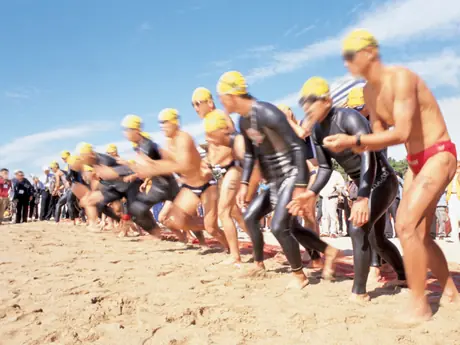
As athletes start the race calendar planning process for the upcoming season, no matter the goal distance, common questions arise. Let's take a look a look at some of those questions; the answers may give you some ideas for planning your season.
If I don't want triathlon to be all-consuming in the New Year but I want the sport to help me maintain a healthy, balanced life, how many races should I do to stay on track and what distances should I target?
For most people, training for and racing sprint and Olympic-distance events is manageable while maintaining balance in life. For sprint-distance events, you can train around four to six hours per week and still go into races feeling strong. For Olympic-distance events, training some six to 10 hours per week will have you feeling strong all the way to the end of the race.
Deciding on the number of races to do may depend on race availability in your area and how much you're willing to travel. Taking race availability into account, the next item to consider is how much you love to race. Some triathletes love to race and would attend a race every weekend rather than do training swims, rides and runs. Others are the opposite—they love to train and attending races is a lot of stress and hassle.
More: How Many Races Should I Do?
If you're unsure where to begin, start with one race per month. These races can be triathlons or single-sport races like running a 10K.
I haven't touched on Ironman or Ironman 70.3 events. Most people find that training for the longer distances requires a bigger time commitment for at least eight to 12 weeks, including race day. Training for the 70.3 distance can be done on six to 11 hours per week and Ironman requires six to a minimum of 13 hours per week.
If you are interested in a longer race, but want life balance too, one strategy is to train for an early season long-distance event. Then enjoy that great fitness to do other sports during the summer, or move to shorter triathlon events.
More: Nail Your Early-Season Peak
If there is a specific race or distance I want to do, how do I plan around it?
When I plan an individual athlete's training, or build out a ready-to-use training plan, I work backwards from race day. First I place the race, or races, on the calendar and then I work back in time to today. I use this strategy to count the number of available weeks of training.
Next, I plan the long workouts closest to race day. For example for sprint racing, I like triathletes to put in at least one long ride that equals the predicted race completion time. I want at least one of these rides completed two or three weeks out from race day.
The week leading into the race should be reduced training for your two or three most important events. Plan to reduce training for some five to seven days, after big races, for recovery. For triathletes that like to race more, training won't be reduced as much leading into several of the lower priority races.
The longest swim and run is typically completed two or three weeks out from race day as well. For sprint and Olympic-distance events, the longest swims and runs are usually the same distance as race day. Long-distance events get a little more complicated, so I won't cover planning for those events in this column.
- 1
- of
- 2
About the Author









Discuss This Article